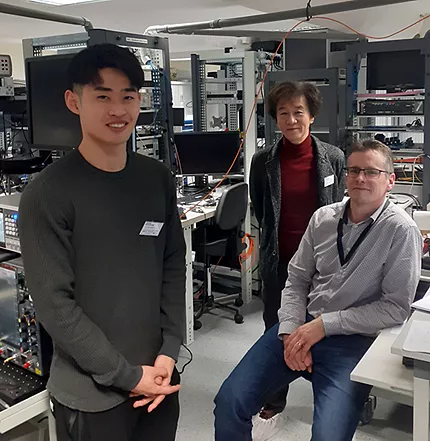Keysight Helps to Achieve 1Tbps Throughput Using Terahertz Frequencies.
The demand for more cellar data and higher data throughputs is insatiable. The goal for 6G is to achieve data throughput rates ten times faster than in 5G, eventually achieving up to 1 terabit per second (Tbps) throughput. This speed will enable use cases such as holographic communications and extended reality experiences that aren’t possible with today’s data speeds.
To reach 1 Tbps speeds, several tens or hundreds of gigahertz of bandwidth are needed, which makes higher frequencies like sub-terahertz (sub-THz) appealing. Extensive research has been conducted into creating early sub-THz communications systems, but components for these frequencies still need to be developed and are very scarce.
In December, Keysight and researchers from France’s Centre National de la Recherche Scientifique (CNRS), Lille University, and Osaka University announced they had broken the 1Tbps barrier. In a paper presented at the Asia-Pacific Microwave Conference, professors Guillaume Ducournau and Tadao Nagatsuma detailed this achievement using a system built with a combination of terahertz photodiodes and an electronics-based receiver covering a range of 500-724 GHz. In this frequency band, they used channel aggregation with 14 carriers and a range of 16 to 64 quadrature amplitude modulation (QAM) to achieve a total data throughput of 1.04 Tbps.
“Terahertz communications have been pushed forward in recent years, with interesting milestones reached using photonics or electronics,” said Prof. Ducournau, who specializes in creating terahertz sources and receivers and applying them to communications-related applications using photonics and photo mixing. “I am excited to see that photonics enabled the first aggregated greater than 1 Tbps sub-THz system, as photonics technologies have accelerated to boost terahertz communication research.”
“I am also so happy to reach a single-lane 1-Tbps data rate, a long-time dream of terahertz communication researchers,” adds Prof. Nagatsuma.
Keysight Helps to Achieve 1Tbps Throughput Using Terahertz Frequencies.
Figure 1: Achieved data rates over terahertz frequencies
To measure the performance of their state-of-the-art system, they used a four-channel Keysight Infiniium UXR‑series oscilloscope coupled with vector signal analysis (VSA) software. Figure 1 shows the measured performance of the carrier aggregated system in yellow between 500-724 GHz, with 14 total carriers. The measured performance of a single carrier at 632 GHz is shown below in Figure 2. The high performance of the UXR made these measurements possible. The four 70 GHz channels and wide supported voltage range made receiving the full bandwidth of their signals possible. In addition, the large library of supported waveforms in the VSA allowed the researchers to demodulate their signals to measure the system throughput easily and successfully.
“The combination of wideband terahertz photodiode, receiver, and the unique performance of Keysight’s UXR really enabled us to succeed in these experiments,” said Prof. Ducournau. “Their advanced instruments are pushing forward our terahertz research.”
Keysight Helps to Achieve 1Tbps Throughput Using Terahertz Frequencies.
Figure 2: Measured throughput of the signal carrier signal at 632 GHz with different modulations. 32-QAM / 40 GBaud (0.2 Tbps, left) and 16-QAM / 40 GBaud (160 Gbps, right).
Photonics is one new technology being investigated to enable communications at sub-THz bands. Whether or not photonics will be widely adopted in the future remains to be seen. Still, Keysight remains committed to providing the tools researchers need to build the next generation of wireless communications devices.
The 6G research is supported by the France 2030 programs, PEPR (Programmes et Equipements Prioritaires pour la Recherche), CPER Wavetech, E.U. TERAOPTICS, and by the Beyond 5G R&D Japan Promotion Program (00901) from the National Institute of Information and Communications Technology (NICT). The PEPR is operated by the Agence Nationale de la Recherche (ANR) under the grants ANR-22-PEEL-0006 (FUNTERA, PEPR ‘Electronics’) and ANR-22-PEFT-0006 (NF-SYSTERA, PEPR 5G and beyond – Future Networks). The Contrat de Plan Etat-Region (CPER) WaveTech is supported by the Ministry of Higher Education and Research, the Hauts-de-France Regional Council, the Lille European Metropolis (MEL), the Institute of Physics of the French National Centre for Scientific Research (CNRS) and the European Regional Development Fund (ERDF). The TERAOPTICS project has received funding from the European Union’s Horizon 2020 research and innovation program under the Marie Skłodowska-Curie grant agreement No. 956857.

